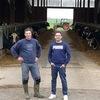Dairy Cows: Effects of Air Velocity
Published: May 4, 2021
Source : Dr. Sohail Basharat (Cow-comfort/Cow-Welfare Expert), JLU University, Giessen, Germany.
An increase in the velocity of air, at a temperature lower than the surface temperature of the animal, has the potential to increase the sensible heat loss of the animal. An augmentation in air velocity will shift the upper critical temperature upwards. An effective ventilation system to reduce heat stress should emphasize the production of high air speed as much as the commonly accepted goal of reducing ambient temperature. Increasing the air velocity lowers the effective temperature producing a wind chill index in hot weather similar to that commonly referred to during cold weather. Between 26°C and 36°C (80°F and 97°F) the rate of rise in rectal temperature was halved with increased air velocity of 1.5 to 3.0 m/s (295 to 590 fpm) as compared to a mean air velocity of 0.5 m/s (98 fpm).

Of the four heat dissipation methods (radiation, convection, evaporation, and conduction) only two, evaporative and convective cooling, are affected directly by air speed. Evaporative cooling, because of the high latent heat of vaporization, is by far the more important if the outer surface is moist. However, if the outer surface has little moisture to vaporize, the increased heat dissipation by increasing air velocity is largely due to convective cooling. Convective cooling does not increase linearly but is a function of the square root of the velocity.

Winds tend to widen the "comfort zone" at high air temperature where cooling is beneficial. An analysis of the relation between wind and heat loss from cows is complicated by the interaction of several factors. Convective cooling rises with increasing air velocity, but in doing so lowers the temperature of the outer surface causing a decrease in the losses by radiation, conduction, and outer surface vaporization. The convective cooling of the outer surface also reduces evaporation from the respiratory tract by reducing respiration rate and the pulmonary ventilation tract by reducing respiration rate and pulmonary ventilation rate. At temperatures below 35°C (95°F) changes in respiration rate and pulmonary ventilation rate caused by increased air velocity were greater between 0.18 and 2.2 m/s (35 and 440 fpm) than between 2.2 and 4.0 m/s (440 and 790 fpm). Vaporization from the skin increases with rising temperature but tends to decrease with rise in air velocity. The only possible explanation for this decrease in vaporization with rising air velocity is that less moisture from sweating reaches the surface of convectively cooled skin. One possible cause is a slower diffusion rate brought about by diminished blood flow through constricted skin capillaries. This also suggests that as convective cooling increases, the cow limits her sweating.

However, at 35°C (95°F) there is an increase in the vaporization rate at high velocity, 4.0 m/s (791 fpm), but not at low velocity, 0.18 m/s (35 fpm). The vaporization curve at low velocity has reached its maximum while the corresponding curve for high velocity continues to rise. In brief, evaporative cooling continues to be effective at a higher temperature range with high air velocity if moisture is present. Increasing air velocity shifts the vaporization curve, thereby increasing evaporative heat loss. This increase in evaporative heat loss extends maximum vaporization and the range of physiologically tolerable temperatures to a higher level. The effect of increasing velocity on evaporative cooling and surface temperature was non-linear, similar to the effect of velocity on convective cooling. The effect was greater from 0.18 to 2.2 m/s (35 and 440 fpm) than from 2.2 to 4.0 m/s (440 and 790 fpm).

The effect of air speed on rectal temperatures at 10°C and 18°C (50°F and 65°F) is negligible. However, at 26°C and 35°C (80°F and 95°F) the cows which develop the highest rectal temperatures at low velocity are cooled most by high velocity. These cows were also those with the highest production levels, indicating greater relief for higher producing cows with increased air speed. Air velocity has no effect on heat production in the "thermoneutrality" zone (5°C to 16°C) (40°F to 60°F), but at 35°C (95°F) heat production was higher at higher air velocity indicating greater milk production potential. Overall, higher air velocities enable cattle to maintain normal body temperature during exposure to heat stress that would normally cause a rise in body temperature.
The higher the milk production and the larger the cow the greater the effect of changing air velocity from 0.22 to 4.0 m/s (43 to 790 fpm) at 35°C (95°F). This may be because heavy milk production is highly correlated with high heat production, and large body size is associated with smaller surface area per unit weight, with consequently greater difficulty in heat dissipation. The results of greater thermal stress may render the larger and heavier milking cows more sensitive to the slightly reduced cooling off reduced air velocity.
Related topics:
Mentioned in this news release:
Recommend
Comment
Share
Recommend
Reply

Would you like to discuss another topic? Create a new post to engage with experts in the community.










